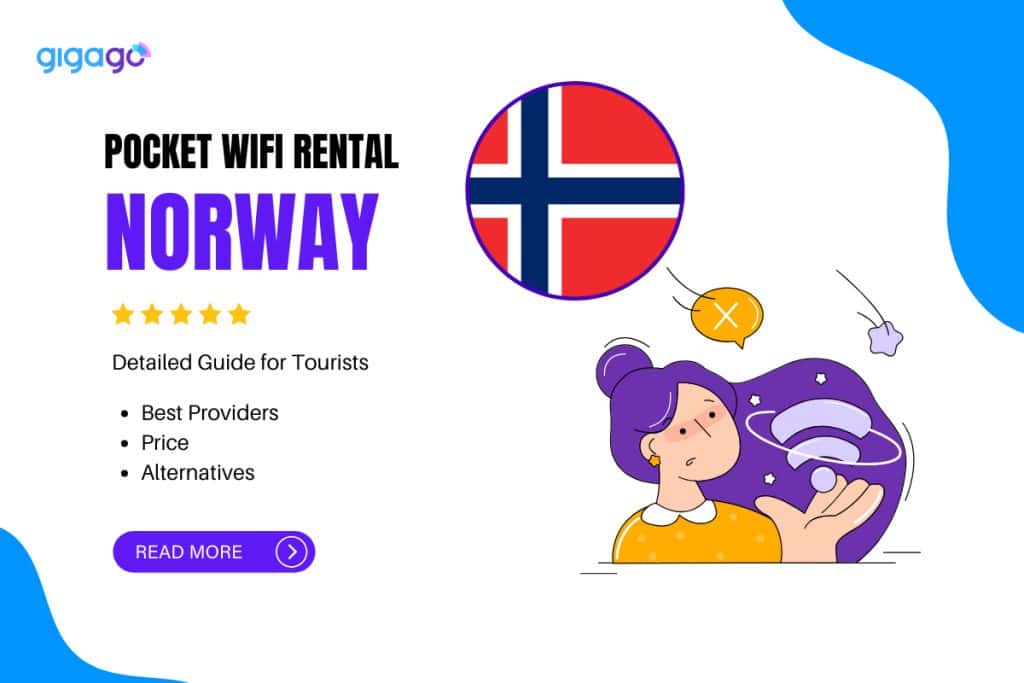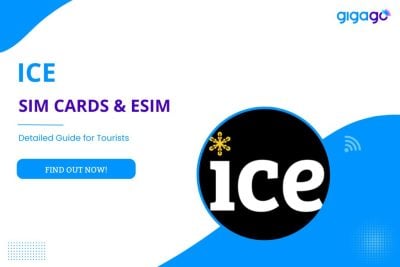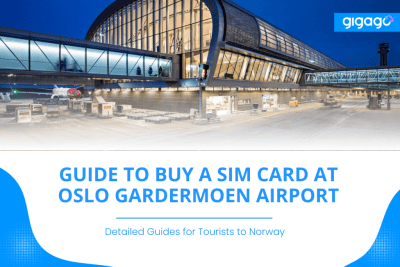This guide helps tourists select the correct SIM card, manage costs, and activate the service. You’ll learn about Ice’s coverage, the best SIM options, eSIM support, and how to purchase and activate your Ice SIM or eSIM.
How To Use Cell Phone In Norway: Traveler’s Guide To Stay Connected
Are you planning to travel to Norway? To make your trip enjoyable, an active phone is an important device to accompany you. you may feel disconnected and have difficulty moving and communicating. Gigago will guide you with simple information on how to use your mobile phone while abroad.

In this article
I. Highlights of Phone Compatibility, Frequencies and Networks in Norway
This essay is about a summary of phone coverage in Norway, so you get the best connection experience when visiting the country.
- Strong coverage in both Urban and Rural areas: In terms of GSM, 4G and 5G networks, phone coverage in Norway is very reliable, especially in urban areas even at peak times. In rural areas, you can still enjoy easy connectivity except in a few remote areas where the power system has not been treated.
- Popular Network in Norway: Norway has two main networks: Telenor and Telia. Telia, which stands out for its speed and coverage throughout the country, is widely used by urban residents. Besides, Telenor also provides reliable connections for not only foreign tourists but also people living in rural areas. Taking into consideration your location and personal needs, travelers can choose the network that suits them.
- Recommendation:
- – Telenor: Being suitable for island tourism and areas with special terrain.
- – Telia: Being suitable for cities and low budgets.
- With this information, you will easily travel and stay in touch anytime, anywhere in Norway.
II. Using a Cell Phone in Norway: A Quick Checklist for Travelers
1. Checking your Phone about the compatibility in Norway
Checking if your phone supports quad-band (850/900/1800/1900 MHz frequencies). This information is about the mobile frequencies used by the top 3 major carriers in Norway:
| Network | Frequency Bands |
| Telenor | 900 MHz (Band 8) 2100 MHz (Band 1 – UMTS/WCDMA) 800 MHz (Band 20 – LTE) 1800 MHz (Band 3 – LTE) |
| Telia (TeliaSonera) | 900 MHz (Band 8) 2100 MHz (Band 1 – UMTS/WCDMA) 800 MHz (Band 20 – LTE) 1800 MHz (Band 3 – LTE) |
| Ice (Ice Group) | 900 MHz (Band 8) 2100 MHz (Band 1 – UMTS/WCDMA) 800 MHz (Band 20 – LTE) 1800 MHz (Band 3 – LTE) |
Note: This information may change depending on technological developments and network strategies of carriers. You should also check information directly from the website or documentation of the provider you are interested in ensuring its accuracy.
2. Checking and Unlocking Your Phone’s Provider in Norway
- Before arriving in Norway, it is important to check your phone’s provider. It offers you unlock internet mobile status to ensure a smooth and efficient network connection. This process not only saves costs but also provides a better travel experience.
- Before leaving the country, you should check the carrier unlock status according to the instructions or interaction with the carrier. It is because you make sure that your phone is ready for use in Norway.
- If your phone is unlocked, it is necessary to consider purchasing a Norwegian SIM card upon arrival to save money and enjoy a diverse network experience.
- In case your phone is not unlocked, purchasing a new device will help you use the Norwegian network and ensure a stable and fast connection.
- Recommendation:
- If you have free time, you should take advantage of your carrier’s international roaming services. This will help you avoid hassles and enjoy your travel without network connection problems.
3. Check your charging plug
- Before arriving in Norway, you need to check your phone is charging plug which is an important step. It is because you can use and avoid any power-related annoyances.
- Checking your charging plug is very important. Unless it is compatible with the Norwegian electricity system, you can consider purchasing a local adapter or plug
- If carrying multiple devices, using a multi-purpose plug can charge multiple devices at the same time, so you can save time and space.
- You should choose lightweight and compact charging plugs to reduce weight and be convenient to carry.
- Pro tip: If possible, you can use a plug with a USB port for charging from multiple devices with just one plug. Moreover, you should buy an additional adapter if your charger is not compatible with your local Norwegian outlet.
III. What Are Options To Use Cellphones In Norway For Tourists?
1. International SIM card for Norway
International roaming in Norway is simple and convenient, although it comes at a high cost. This becomes the easiest way but also almost the most expensive option for those who aim to come to the country.

Step 1: Choosing Airport
Choosing the international airport in Norway that suits your plans. According to a recent study, Oslo Gardermoen is a popular choice, but there are many other airports such as Stavanger, Bergen, and Trondheim.
Step 2: Booking Flight
Booking flights to the international airport of your choice. It helps you make sure to choose a flight with a changeover delay that matches your planned schedule.
Step 3: Roaming procedure
Upon landing, you will go through exit procedures if necessary.
Tracking your trip information for airports and international roaming gateways.
At the roaming airport, you need to comply with security rules and go through immigration procedures.
Step 4: Connecting to the Next Flight
Track trip information for your next port and trip information.
Use domestic transportation or walk to the connection gate.
Go through immigration procedures if necessary.
► Recommendations:
- Always check the immigration requirements and procedures of your destination country.
- Making sure there is enough waiting time between flights to avoid delays.
2. Buying a prepaid Norwegian SIM card
If you are a tourist or plan to take a business trip to Norway. You will need to have an Internet connection and phone calls during your stay without having to buy multiple SIM cards. In addition, you may want to consider purchasing a Norway SIM card Norway payment in advance.
Where to Buy:
Prepaid SIM cards can be purchased at mobile shops, convenience stores, or mobile service counters at Norwegian airports and city centers
Advantages:
- Providing convenience for tourists and business travelers, helping them easily connect to the Internet and make calls.
- Users can keep the same landline phone number during their stay in Norway.
Disadvantages:
- Purchasing a prepaid SIM card may be more expensive than purchasing a local SIM in Norway.
- In less developed or remote areas, signal and service may be limited.
► Recommendation: If you plan to use the service long-term, you should consider postpaid SIM plans which may bring more benefits and cost savings.
3. Pocket Wi-Fi
Renting a pocket WiFi hotspot is ideal for those traveling to Norway, where mobile networks and Internet connectivity are not only important but also is key to a smooth travel experience. For those who don’t want to rely on a local SIM or have difficulty setting up a network directly on their phone, renting a pocket WiFi hotspot helps travelers browse the web, share photos, and communicate without being worried about connection shortcomings
Advantages:
- Helping travelers connect to the Internet anytime, anywhere during their trip.
- Allowing multiple devices to connect at the same time, especially suitable for traveling groups. As a result, you can save costs and easily share connections.
- Many companies provide pocket WiFi hotspot rental services to support door-to-door delivery and also reduce inconvenience for tourists. This is especially useful when traveling to a new country.
Disadvantages:
- Renting a pocket WiFi hotspot can be more expensive than buying a local SIM. This can put financial pressure, especially on those who aim to reduce travel costs.
- In remote areas, WiFi signals may be weak or absent, making connection difficult. This can be a challenge for travelers who want to explore wild and less technologically developed lands.
- If you travel to Norway and want a flexible data connection on your mobile phone, buying an ESIM is the best choice. In terms of all aspects including cost, and quality as well as ensuring speed during the process phone settings, visitors can access easily.
Where to buy ESIM for Norway:
The Travel ESIM for Norway can be purchased online on GIGAGO or in mobile phone stores and retail locations.
Popular mobile carriers in Norway such as Telenor, Telia, Ice.net can provide travel ESIM.
Advantages :
Providing convenience and flexibility for data connectivity while traveling in Norway.
ESIM eliminates the need to change physical SIMs, saving time and hassle.
Activating an ESIM is usually very quick and easy.
Disadvantage:
Travel ESIMs typically focus primarily on data, which may not be suitable for those who need to make a lot of calls or texts.
Some ESIM services may cost more than local SIM.
► Recommendation:
Before purchasing an ESIM, check availability and network coverage in the areas you plan to visit during your trip.
4. Free WiFi in Norway
People traveling to Norway and want to save on Internet costs by using free WiFi.
Where is Free WiFi:
- Many hotels and motels offer free WiFi to guests.
- Some shops, eateries, and cafes also have free WiFi for customers.
- Public areas such as libraries, parks, and shopping malls often have free WiFi service.
Pros:
- Using free WiFi helps save on international mobile service costs.
- Suitable for short-term trips if there is no need to buy a SIM card or rent a WiFi transmitter.
Cons:
- Free WiFi may have speed and capacity limits.
- Because of the location, the WiFi signal may be unstable.
Warning: Avoid accessing unsecured WiFi networks to ensure the safety of personal information.
IV. Will My Local Network Work In Norway?
Yes, your phone will work in Norway as long as it is compatible with the local network.

- In terms of mobile phone use in Norway, you need to check that your phone supports the common frequency bands used by operators here. Moreover, Norway uses the frequency bands 900 MHz (Band 8), 2100 MHz (Band 1 – UMTS/WCDMA), 800 MHz (Band 20 – LTE), and 1800 MHz (Band 3 – LTE).
- If your phone is compatible with these bands, you can use it in Norway without major problems. However, it ensures the best compatibility, you should contact your provider or phone manufacturer to check details about your device’s international availability.
- Additionally, if you intend to use mobile service in Norway for a long time, you may take into consideration purchasing a discussion SIM or ESIM card for more convenience in connecting when using the service.
V. Gigago ESIM – An Alternative To Get Internet In Norway With Your Cell Phone
Gigago ESIM emerges as the top choice for travelers in order to seek seamless internet connectivity in Norway. This ESIM provider stands out for its extensive range of plans, exceptional customer support, and reliable network signals. Following the below information, we break down the key advantages of opting for Gigago ESIM during your travels.

- Gigago offers more ESIM plans than competitors for you to ensure a range of choices which suitable for different budgets and travel durations.
- In selective countries, Gigago’s ESIM comes with a phone number, as a result, it allows me traditional calling and texting alongside data usage.
- Gigago provides many specific features for customers in multiple languages, so it ensures quick and effective assistance for any issues travelers may encounter.
- Gigago ESIM utilizes signals from leading networks, widespread, and stable connectivity throughout Norway.
- The ESIM employs multi-signals from various networks that offer a reliable backup system, particularly useful when transitioning between urban and rural areas in Norway.
- Gigago ESIM is known for its simplicity in purchasing and setting up. The service caters to various needs with multiple plan options. It offers to provide users with a hassle-free experience.
- Users can expect stable and fast internet access, ensuring that they stay connected wherever their travels take them in Norway.
- Gigago’s customer support caters to a global audience with assistance available in multiple languages, including English, Vietnamese, Japanese, Chinese, Spanish, and French.
- Gigago ESIM is a reliable and user-friendly choice. It is the reason why it has become an excellent companion for travelers exploring Norway.
VI. Which Norway ESIM plan should you choose for your trip?
Taking consideration into the length of your stay, your internet habits, and your specific needs:
| Time (Days) | Benefits | Note |
| 3-7 | For short trips. Enough data for basic internet use. | Data – Only |
| 7-14 | Extensive data suitable for average use. Suitable for exploring many locations. | Data – Only |
| 14-21 | Long time with large amount of data Suitable for longer vacations or business trips. | Data + Voice + Text. |
| 21-30 | Sufficient data for extended vacations. Perfect for long vacations or long-term work. | Data + Voice + Text. |
| 30+ | Unlimited data for extended trips. Customized for those traveling for business or long-term vacation. | Data + Voice + Text. |
Whether you’re a short-term adventurer or a long-term businessman, Gigago will give you many variety of choices:
VII. FAQs
How to get an internet connection for a mobile phone in Norway?
How to buy a phone SIM in Norway?
Is it necessary to unlock the phone to use a Norwegian SIM?
How to top up your phone in Norway?
How to make international calls from Norway?
Is ESIM widely accepted in Norway?
VIII. Conclusion
Using a cell phone in Norway offers convenience and easy connectivity. However, it’s essential to choose a suitable plan to avoid unexpected fees. On top of that, a mobile phone facilitates connection and information in daily life.





